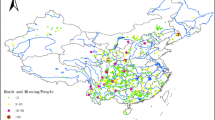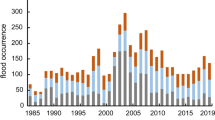Abstract
Flash floods are among the most severe natural hazards that cause disastrous environmental and human impacts. The city of Gabes (Southern Tunisia) is prone to harmful flooding, because of its location on a low plane and its extremely erratic rainfall distribution. Flood risk associated with this is expected to increase further in the coming years due to the high rate of urbanization and an ever growing population. A particular interest is given to a major flooding event, which is the single event that hit the region in the summer season over the last century. Statistical tools, satellite images treatment and analysis, meteorological observation data, Geographic Information System (GIS), and survey data were considered in order to understand and explore the different causes of this disaster, its extent and its consequences. ERA5 is a new global reanalysis tool which was used in this study to evaluate spatial and temporal extent of the examined major rainfall event. A survey was also conducted with 108 participants from different areas of the city. This latter revealed a variety of causes which amplified the flood disaster. The results obtained showed that the flood risk depends not only on rainfall intensity and the event total duration but also on land use, urban development, oasis destruction, and other anthropogenic settings. In this study, procedures are developed to classify and rank the causes and the impacts from the least to the most severe, with special attention to certain problematic spots in the city that were analyzed in detail. Flooding extent areas were estimated and were shown to be in good agreement with the observation data. Recommendations and scenarios to mitigate flood risk are also provided.










Similar content being viewed by others
References
Attogouinon A, Lawin A, M’Po YN, Houngue R (2017) Extreme precipitation indices trend assessment over the Upper Oueme River Valley-(Benin). Hydrology 4:36
Barrera A, Altava-Ortiz V, Llasat MC et al (2007) Heavy rain prediction using deterministic and probabilistic models- the flash flood cases of 11-13 October 2005 in Catalonia (NE Spain). Adv Geosci 12:121–126
Bates, B. Kundzewicz, Z. Wu, S. (2008). Climate change and water. Intergovernmental Panel on Climate Change Secretariat
Bourges J, 1974. Aperçu sur l’hydrologie du centre sud Tunisien : Réseau d’observations et crues exceptionnelles, O.R.S.T.O.M, 1–163
Brunetti M, Buffoni L, Mangianti F, Maugeri M, Nanni T (2004) Temperature, precipitation and extreme events during the last century in Italy. Glob Planet Chang 40:141–149
Calianno M, Ruin I, Gourely JJ (2013) Supplementing flash flood reports with impacts classifications. J Hydrol 477:1–16
Dahri N (2018) Caractérisation quantitative et qualitative des flux d'eaux pluviales dans la ville de Gabès : apports des outils hydrologiques cartographiques et géochimiques. Thèse de doctorat:1–225
Dahri N, Abida H (2017) Monte Carlo simulation-aided analytical hierarchy process (AHP) for flood susceptibility mapping in Gabes Basin (southeastern Tunisia). Environ Earth Sci 76(7):302
Data C (2009) Guidelines on analysis of extremes in a changing climate in support of informed decisions for adaptation. In: World Meteorological Organization
Deng L, McCabe M, Stenchikov F, Evans G, Kucera JP, P. A. (2015) Simulation of flash-flood producing storm events in Saudi Arabia using the weather research and forecasting model. J Hydrometeorol 16:615–630
Dewan TH (2015) Societal impacts and vulnerability to floods in Bangladesh and Nepal. Weather and Climate Extrem 7:36–42
Elmer F, Hoymann J, Duthmann D et al (2012) Drivers of flood risk change in residential areas. Nat Hazards Earth Syst Sci 12:1641–1657
Fehri N (2014) L’aggravation du risque d’inondation en Tunis : éléments de réflexion. Physio-Géographie 8:149–175
Fehri N, Yadh Z (2016) Etude de l'impact de l'extension et de la densification du tissu urbain sur les coefficients de ruissellement dans le bassin versant des oueds ElGhrich et ElGreb (Tunis) par l'application de la méthode SCS aux évènements de septembre 2003. Physio-Géographie 10:61–79
Field CB, Barros V, Stocker TF et al (2012) Managing the risks of extreme events and disasters to advance climate change adaptation: special report of the intergovernmental panel on climate change. Cambridge University Press, Cambridge
Gauma E, Bain V, Bernardaza P et al (2009) A compilation of data on European flash floods. J Hydrol 367:70–78
Gond V, Bartholome E, Ouattara F, Nonguierma A, Bado L (2004) Surveillance et cartographie des plans d’eau et des zones humides et inondables en régions arides avec l’instrument vegetation embarqué sur spot-4. Int J Remote Sens 17:987–1004
Groisman PY, Knight RW, Karl TR et al (2004) Contemporary changes of the hydrological cycle over the contiguous UnitedStates: trends. J Hydrometeorol 5:64–85
Gumbel EJ (1958) Statistics of extremes. Columbia University Press, New York
Guzzetti F, Tonelli G (2004) Information system on hydrological geomorphologic catastrophes in Italy (SICI): a tool for managing landslide and flood hazards. Nat Hazards Earth Syst Sci 4:213–232
Haraguchi M, Lall U (2014) Floods risks and impacts: a case study of Thailand’s flood in 2011 and research questions for supply chain making. Int J Disaster Risk Reduct 9:1–17
Haylock MR, Peterson T, Abreu de Sousa JR, Alves LM, Ambrizzi T et al (2006) Trends in total and extreme South American rainfall in 1960-2000 and links with sea surface temperature. J Clim 19:1490–1512
Hersbach H, Dee D (2016) ERA5 reanalysis is in production, ECMWF newsletter 147, ECMWF. UK, Reading
Hountondji YC, de Longueville F, Ozer P. (2011). Trends in extreme rainfall events in Benin (West Africa), 1960–2000, proceedings of the 1st international conference on energy. Environment and Climate Change
ITT Visual Information Solutions (2009) I.V.I. in atmospheric correction module: Quac and Flaash User’s guide, version 4.7. ITT Visual Information Solutions, Boulder
Kilani M (2014) The collapse of the oasis under the impact of the state. The Tunisian case. In: Colloque international: les espaces oasiens: des écosystèmes à la mise en valeur patrimoniale et touristique. Paris Sorbonne University of Abu Dhabi (Reem Island), Abu Dhabi
Kitagawa N, Michinoto K (1994) Meteorological and electrical aspects of winter thunderclouds. J Geophys Res 99:10713–10721
Knight EJ, Kvaran G (2014) Landsat-8 operational land imager design, characterization and performance. Remote Sens 6:10286–10305
Barbé LL, Lebel T, Tapsoba D (2002) Rainfall variability in West Africa during the years 1950-90. J Clim 15:187–202
Llasat MC, Lopez L, Bornolas M et al (2008) Flash floods in Catalonia: the social perception in a context of changing vulnerability. Adv Geosci 17:63–70
Marchi L et al (2010) Characterization of selected extreme flash floods in Europe and implications: for flood risk management. J Hydrol 394:118–133
Menad, W. Douvient, J. Arnaud-Fassetta, G. (2009). Le risque d’inondation dans l’oued koriche (massif de Bouzaréah, alger ouest) : analyse systemique de l’alea Et facteurs de vulnerabilite. Risques naturels en Méditerranée Occidentale, pp. 207–217
Mertikas P, Zervakis ME (2001) Exemplifying the theory of evidence in remote sensing image classification. Int J Remote Sens 6:1081–1095. https://doi.org/10.1080/01431160118597
Millán MM (2014) Extreme hydrometeorological events and climate change predictions in Europe. J Hydrol 518:206–224
Nordstrom KF, Mitteager WA (2001) Perceptions of the value of natural and restored beach and dune characteristics by high school students in New Jersey, USA. Ocean Coast Manag 44:545–559
Paeth H, Fink A, Pohle H, Keis S, Mächel F, Samimi H, C. (2011) Meteorological characteristics and potential causes of the 2007 flood in sub-Saharan Africa. Int J Climatol 31:1908–1926
Parajka J, Kohnova S, Balint G et al (2011) Seasonal characteristics of flood regimes across the Alpine- Carpathian range. J Hydrol 394:78–89
Sahani M, Moeyersons J, Vanescsteele I, Trefois P, Ozer P (2011) Evolution des caractéristiques pluviométriques dans la zone urbaine de Butembo (RDC) de 1957 à 2010. Geo-Eco-Trop 36:121–136
Sani Y, Ahmed N, Abdalla RF (2009) Multi criteria analysis for flood vulnerable areas in Hadejia – Jama’ are river basin, Nigeria. Eur J Sci Res 42:71–83
Sharma LK, Nathawat MS, Sinha S (2013) Top-down and bottom-up inventory approach for above ground forest biomass and carbon monitoring in REDD framework using multi-resolution satellite data. Environ Monit Assess 185:8621–8637. https://doi.org/10.1007/s10661-013-3199-y
The 23rd OSCE Economic and Environmental Forum, 2015. Water governance in the OSCE area – increasing security and stability through co-operation, SECOND PREPARATORY MEETING Belgrade, 11–13 May 2015
Thieken AH, Muller M, Kreibich H et al (2005) Flood damage and influencing factors: new insights from the august 2002 flood in Germany. Water Resour Res 41:1–16
Thorne C (2014) Geographies of UK flooding in 2013/4. Geogr J 180:297–309
Tilahun K (2006) The characterisation of rainfall in the arid and semi-arid regions of Ethiopia. Water SA 32(3):429–436
Tošić I, Unkašević M, Putniković S (2017) Extreme daily precipitation: the case of Serbia in 2014. Theor Appl Climatol 128:785–794
Wang C, Graham RM, Wang K, Gerland S, Granskog MA, (2018). Comparison of ERA5 and ERA-Interim near surface air temperature and precipitation over Arctic sea ice: Effects on sea ice thermodynamics and evolution. In Proceedings of the AGU Fall Meeting Abstracts, Washington, DC, USA (pp. 10–14)
Williams D (2008) Landsat 7 science Data users handbook. Washington, DC, NASA, p 12
Xoplaki E, Gonzalez-Rouco FJ, Luterbacher J et al (2003) Mediterranean summer air temperature variability and its connection to the large-scale atmospheric circulation and SSTs. Clim Dyn 20:723–739
Xoplaki E, Gonzalez-Rouco FJ, Luterbacher J et al (2004) Wet season Mediterranean precipitation variability: influence of large-scale dynamics. Clim Dyn 23:63–78
Yair Y, Shalev S, Erlich Z et al (2014) Lightning flash multiplicity in eastern Mediterranean thunderstorms. Nat Hazards Earth Syst Sci 14:165–173
Acknowledgments
The authors wish to thank all the participants involved in the survey and the Tunisian Ministry of Agriculture and Water Resources for their support.
Author information
Authors and Affiliations
Corresponding author
Ethics declarations
Conflict of interest
The authors declare that there is no conflict of interest.
Additional information
Responsible Editor: Marouane Temimi
Rights and permissions
About this article
Cite this article
Dahri, N., Abida, H. Causes and impacts of flash floods: case of Gabes City, Southern Tunisia. Arab J Geosci 13, 176 (2020). https://doi.org/10.1007/s12517-020-5149-7
Received:
Accepted:
Published:
DOI: https://doi.org/10.1007/s12517-020-5149-7




